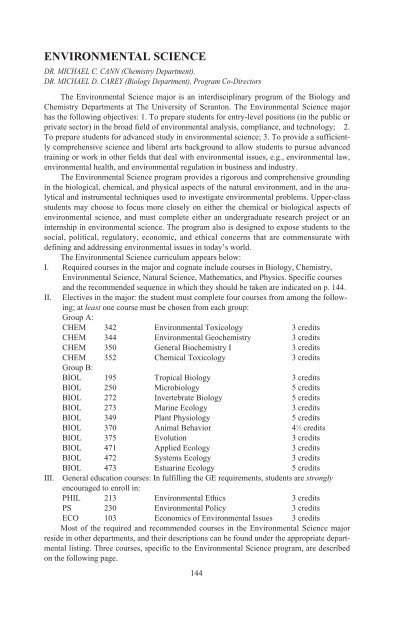- Page 1 and 2:
University of Scranton 2002-2003 Ca
- Page 3 and 4:
2002-2003 University of Scranton AC
- Page 5 and 6:
ACCREDITATION The University of Scr
- Page 7 and 8:
THE KANIA SCHOOL OF MANAGEMENT.....
- Page 9 and 10:
THE SEAL OF THE UNIVERSITY OF SCRAN
- Page 11 and 12:
THE CAMPUS The University’s 54-ac
- Page 13 and 14:
As an urban American university, Th
- Page 15 and 16:
and encourages continued dialogue b
- Page 17 and 18:
FULBRIGHT AND OTHER INTERNATIONAL F
- Page 19 and 20:
1989 Kim Marie Newak...............
- Page 21 and 22:
PHI ALPHA THETA* International Hono
- Page 23 and 24:
1982. Basic requirements: at least
- Page 25 and 26:
ADMISSION The Admissions Committee
- Page 27 and 28:
ACADEMIC DEVELOPMENT PROGRAM Applic
- Page 29 and 30:
The University of Scranton requires
- Page 31 and 32:
a personal illness or accident. In
- Page 33 and 34:
“G” session . . . . . . . . . .
- Page 35 and 36:
LOANS FEDERAL PERKINS LOAN PROGRAM.
- Page 37 and 38:
1999-2003 Presidential Scholarship
- Page 39 and 40:
Those interested in learning more a
- Page 41 and 42:
THE CRUCIANI FAMILY SCHOLARSHIP--Do
- Page 43 and 44:
THE JOHN AND LUCILLE GUZEY SCHOLARS
- Page 45 and 46:
THE FRANK J. AND MAE C. MacENTEE ME
- Page 47 and 48:
THE FRANK O’HARA SCHOLARSHIP—Th
- Page 49 and 50:
THE AMELIA SURACI SCHOLARSHIP—Thi
- Page 51 and 52:
THE CHAIR IN JUDAIC STUDIES - from
- Page 53 and 54:
DEGREE PROGRAMS The University offe
- Page 55 and 56:
STUDY ABROAD PROGRAM The Study Abro
- Page 57 and 58:
THE KANIA SOM ACADEMIC ADVISING CEN
- Page 59 and 60:
A degree represents the successful
- Page 61 and 62:
D at 1.0. An F yields no quality po
- Page 63 and 64:
DROPPING AND ADDING CLASSES Student
- Page 65 and 66:
WALKER POLICY Undergraduates who ar
- Page 67 and 68:
THE UNIVERSITY OF SCRANTON GENERAL
- Page 69 and 70:
Curriculum 2000 General Education R
- Page 71 and 72:
LIT 205 Modern Latin American Liter
- Page 73 and 74:
NSCI 286H Elements of Natural Scien
- Page 75 and 76:
SPAN 211 Intermediate Spanish I SPA
- Page 77 and 78:
LIT 209 Masterworks of Russian and
- Page 79 and 80:
OPTIONS FOR UNDECLARED FRESHMEN Stu
- Page 81 and 82:
The College of Arts and Sciences Th
- Page 83 and 84:
ART HISTORY ARMU 140-141 Dr. Dunn,
- Page 85 and 86:
ARTH 221 Dr. Miller-Lanning Ninetee
- Page 87 and 88:
MUS 226 Staff Romantic Music of the
- Page 89 and 90:
BIOLOGY Dept. and No. Descriptive T
- Page 91 and 92:
BIOL 210 Dr. McDermott *Introductor
- Page 93 and 94:
BIOL 352 Dr. Kwiecinski * Histology
- Page 95 and 96: CHEMISTRY DR. DAVID E. MARX, Chairp
- Page 97 and 98: BIOCHEMISTRY PRE-PROFESSIONAL TRACK
- Page 99 and 100: CHEMISTRY-COMPUTERS The Chemistry-C
- Page 101 and 102: In cases where a student withdraws
- Page 103 and 104: CHEM 351 Dr. Wasilewski General Bio
- Page 105 and 106: COMMUNICATION PROF. EDWARD F. WARNE
- Page 107 and 108: COMMUNICATION Dept. and No. Descrip
- Page 109 and 110: COMM 228 Staff (D)Intercultural 3 c
- Page 111 and 112: COMM 332 Staff Documentary Film 3 c
- Page 113 and 114: COMPUTING SCIENCES PROF. RICHARD M.
- Page 115 and 116: CMPS 144 Staff Computer Science II
- Page 117 and 118: CMPS 362 Staff Numerical Analysis 3
- Page 119 and 120: MINOR. A minor in Criminal Justice
- Page 121 and 122: CJ 312 Prof. Cimini Criminal Law 3
- Page 123 and 124: ENGINEERING DR. ROBERT A. SPALLETTA
- Page 125 and 126: ELECTRONICS-BUSINESS The state of t
- Page 127 and 128: PRE-ENGINEERING The University prov
- Page 129 and 130: EE 241 Staff Circuit Analysis 4 cre
- Page 131 and 132: ENGLISH DR. JONES DeRITTER, Chairpe
- Page 133 and 134: All ENLT courses numbered 200 or ab
- Page 135 and 136: ENLT 221 Dr. Whittaker (W)Woody All
- Page 137 and 138: ENLT 244 Drs. Engel, Whittaker Mode
- Page 139 and 140: ENLT 362 Dr. Whittaker Literature &
- Page 141 and 142: THEATRE PROF. RICH LARSEN, Program
- Page 143 and 144: THTR 210 Prof. O’Steen Intermedia
- Page 145: WRITING All Writing courses have WR
- Page 149 and 150: FOREIGN LANGUAGES AND LITERATURES D
- Page 151 and 152: INTERNATIONAL LANGUAGE-BUSINESS The
- Page 153 and 154: FREN 320 Staff (CL)Introduction to
- Page 155 and 156: GERM 423 Dr. Kamla Realism and Natu
- Page 157 and 158: RUSS 211-212 Staff *Intermediate Ru
- Page 159 and 160: SPAN 422 Staff Spanish-American Dra
- Page 161 and 162: LAT 311-312 Dr. Wilson Readings in
- Page 163 and 164: INTERNATIONAL STUDIES A major in In
- Page 165 and 166: twentieth century; African-American
- Page 167 and 168: HIST 295 Dr. DeMichele (CH)Britain:
- Page 169 and 170: HIST 335 Staff World War II, Cold W
- Page 171 and 172: BIOMATHEMATICS The Biomathematics m
- Page 173 and 174: MATH 201 Staff (Q,W)Algebra 3 credi
- Page 175 and 176: MEDIA AND INFORMATION TECHNOLOGY DR
- Page 177 and 178: MILITARY SCIENCE LTC. GREGORY HOCH
- Page 179 and 180: MS 101-102 Staff Concepts of 2 cred
- Page 181 and 182: NEUROSCIENCE DR. TIMOTHY CANNON, Di
- Page 183 and 184: PHILOSOPHY DR. WILLIAM V. ROWE, Cha
- Page 185 and 186: PHIL 219 Staff Russian Philosophy 3
- Page 187 and 188: PHIL 312 Dr. Rowe (P)Modern Philoso
- Page 189 and 190: PHIL 412 Dr. Casey (P, D)Art and Me
- Page 191 and 192: BIOPHYSICS The Biophysics major is
- Page 193 and 194: laws of optics, cameras, developmen
- Page 195 and 196: POLITICAL SCIENCE DR. LEONARD W. CH
- Page 197 and 198:
PS 130-131 Staff (S)American Nation
- Page 199 and 200:
PS 310 Staff Judicial Politics 3 cr
- Page 201 and 202:
PS 384 Staff Special Topics in 3 cr
- Page 203 and 204:
PSYCHOLOGY Dept & No Descriptive Ti
- Page 205 and 206:
categories, and problem solving. Th
- Page 207 and 208:
SOCIOLOGY PROF. JOSEPH F. CIMINI, E
- Page 209 and 210:
MINOR: A minor in Gerontology will
- Page 211 and 212:
SOC 232 Prof. Cimini (D)Great Ameri
- Page 213 and 214:
GERO 232 Prof. Naughton Aging and D
- Page 215 and 216:
THEOLOGY/RELIGIOUS STUDIES Dept. an
- Page 217 and 218:
T/RS 225 Fr. Sable, S.J. Introducti
- Page 219 and 220:
T/RS 308 Dr. S. Mathews (P)The Grea
- Page 221 and 222:
T/RS 331 Drs. Benestad, Pinches, (P
- Page 223 and 224:
INTERDISCIPLINARY COURSES * INTD 10
- Page 225 and 226:
The Kania School of Management The
- Page 227 and 228:
Management of People and Teams, Man
- Page 229 and 230:
serves as an excellent foundation f
- Page 231 and 232:
ACC 252 Staff Financial Accounting
- Page 233 and 234:
ACCOUNTING INFORMATION SYSTEMS DR.
- Page 235 and 236:
AIS 362 Dr. Kakumanu Database Manag
- Page 237 and 238:
ECONOMICS DR. SATYAJIT GHOSH, Chair
- Page 239 and 240:
ECO 362 Dr. Ghosh, Dr. Nguyen Inter
- Page 241 and 242:
ELECTRONIC COMMERCE DR. PRASADARAO
- Page 243 and 244:
EC 461 Dr. Prasad Kakumanu Internet
- Page 245 and 246:
EMT 351 Staff Business Process Over
- Page 247 and 248:
FINANCE DR. SATYAJIT GHOSH, Chairpe
- Page 249 and 250:
INTERNATIONAL BUSINESS DR. TRUSSLER
- Page 251 and 252:
IB 476 Staff U.S.-East Asia Trade 3
- Page 253 and 254:
MANAGEMENT Dept. and No. Descriptiv
- Page 255 and 256:
MGT 362 Dr. Goll, Staff Employee-Ma
- Page 257 and 258:
MARKETING DR. GERALD BIBERMAN, Chai
- Page 259 and 260:
OPERATIONS AND INFORMATION MANAGEME
- Page 261 and 262:
OIM 366 Dr. Cattopadhay Supply Chai
- Page 263 and 264:
COUNSELING AND HUMAN SERVICES DR. O
- Page 265 and 266:
HUMAN SERVICES CONCENTRATION IN REH
- Page 267 and 268:
HS 331 Staff Health and Behavior 3
- Page 269 and 270:
HS 440 Staff Job Development 3 cred
- Page 271 and 272:
the completed forms. The completed
- Page 273 and 274:
ELEMENTARY EDUCATION Dept. and No.
- Page 275 and 276:
SECONDARY EDUCATION (CHEMISTRY) Dep
- Page 277 and 278:
SECONDARY EDUCATION (ENGLISH) Dept.
- Page 279 and 280:
SECONDARY EDUCATION (LATIN) Dept. a
- Page 281 and 282:
SECONDARY EDUCATION (MODERN LANGUAG
- Page 283 and 284:
SECONDARY EDUCATION (SOCIAL STUDIES
- Page 285 and 286:
The following courses are not avail
- Page 287 and 288:
EDUC 310 Staff Special Topics in Ed
- Page 289 and 290:
EDUC 363 Staff Teaching Special Lea
- Page 291 and 292:
EDUC 476 Staff Planning in Secondar
- Page 293 and 294:
PHED 202 Dr. Wodder Sports Administ
- Page 295 and 296:
EXSC 212 Dr. Deitrick *Nutrition in
- Page 297 and 298:
HEALTH ADMINISTRATION Dept. and No.
- Page 299 and 300:
HEALTH ADMINISTRATION Concentration
- Page 301 and 302:
HUMAN RESOURCES STUDIES DR. DANIEL
- Page 303 and 304:
MINOR: To minor in Human Resources
- Page 305 and 306:
NURSING DR. PATRICIA HARRINGTON, Ch
- Page 307 and 308:
NURS 100 Dr. Garrett, Prof. Nicoter
- Page 309 and 310:
NURS 352 Dr. Farrell, Staff Mental
- Page 311 and 312:
NURS 475 Dr. Desmond, Staff Critica
- Page 313 and 314:
OCCUPATIONAL THERAPY MAJOR MAJOR GE
- Page 315 and 316:
OT 356 Prof. Wolf Functional Neuroa
- Page 317 and 318:
OT 560 Dr. Ciaravino Advanced Inter
- Page 319 and 320:
PHYSICAL THERAPY DR. EDMUND M. KOSM
- Page 321 and 322:
MASTER OF PHYSICAL THERAPY (MPT) De
- Page 323 and 324:
PT 350 Prof. Leininger Introduction
- Page 325 and 326:
muscular disorders, peripheral nerv
- Page 327 and 328:
Dexter Hanley College The Dexter Ha
- Page 329 and 330:
Group 2: Major, cognate and general
- Page 331 and 332:
READMISSION Once accepted into Dext
- Page 333 and 334:
B.S. IN NURSING FOR R.N. STUDENTS D
- Page 335 and 336:
B.S. IN NURSING FOR LPN STUDENTS DR
- Page 337 and 338:
Other: NCLEX Review Course Note: Pr
- Page 339 and 340:
PROFESSIONAL TRACK IN LIBERAL STUDI
- Page 341 and 342:
COMPUTER ENGINEERING General Educat
- Page 343 and 344:
GERONTOLOGY General Education GE NS
- Page 345 and 346:
POLITICAL SCIENCE To earn the Assoc
- Page 347 and 348:
CERTIFICATE IN CHEMICAL-ABUSE COUNS
- Page 349 and 350:
CERTIFICATE PROGRAMS IN BUSINESS/MA
- Page 351 and 352:
College-Level Examination Program (
- Page 353 and 354:
Full-time students in Dexter Hanley
- Page 355 and 356:
Dexter Hanley College Student-Gover
- Page 357 and 358:
THEOLOGY T/RS 121-122 Theology I-II
- Page 359 and 360:
MASTER’S DEGREE PROGRAMS The Univ
- Page 361 and 362:
Honors and Interdisciplinary Progra
- Page 363 and 364:
PHIL 120J Fr. McKinney Introduction
- Page 365 and 366:
ADMISSION TO THE HONORS PROGRAM App
- Page 367 and 368:
BLDR 455 Policy and Planning 3 cred
- Page 369 and 370:
ENVIRONMENTAL STUDIES CONCENTRATION
- Page 371 and 372:
ITALIAN STUDIES CONCENTRATION DR. V
- Page 373 and 374:
PEACE AND JUSTICE STUDIES PROGRAM P
- Page 375 and 376:
INTERNSHIP PROGRAMS The University
- Page 377 and 378:
In addition to these skills and val
- Page 379 and 380:
The Association of American Medical
- Page 381 and 382:
Outside the Classroom Much of a stu
- Page 383 and 384:
clarification of values, the abilit
- Page 385 and 386:
INTERCOLLEGIATE ATHLETICS The Unive
- Page 387 and 388:
(For room-and-board fee and housing
- Page 389 and 390:
PERFORMANCE MUSIC AT THE UNIVERSITY
- Page 391 and 392:
CAMPUS MINISTRY As a Catholic insti
- Page 393 and 394:
Robet J. Bednar, Jr., ‘69 Michael
- Page 395 and 396:
Panos Apostolidis, Ph.D. (1977-1989
- Page 397 and 398:
Michael D. Carey D. et U.* (1978) P
- Page 399 and 400:
Daniel V. Fraustino, D. et U.* (198
- Page 401 and 402:
Richard Klonoski, D. et U.* (1981)
- Page 403 and 404:
Robert A. Parsons, D. et U.* (1979)
- Page 405 and 406:
Anne Marie Toloczko (1992) Associat
- Page 407 and 408:
Stacy Andes (2000) Assistant Wellne
- Page 409 and 410:
Stephen Gilbody (1997) Network Admi
- Page 411 and 412:
Aileen McHale (1988) Assistant Dire
- Page 413 and 414:
Thomas P. Smith (1989) Licensed Psy
- Page 415 and 416:
ACCREDITATION The Association to Ad
- Page 417 and 418:
Index Academic Code of Honesty 55 A
- Page 419 and 420:
Occupational Therapy 310 Operations
















